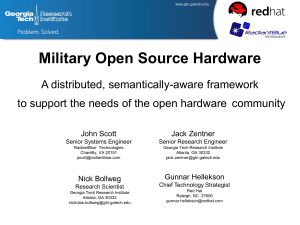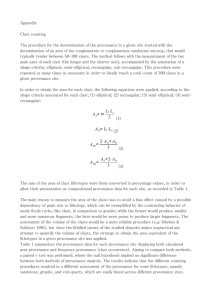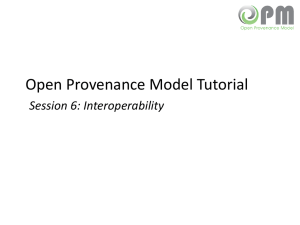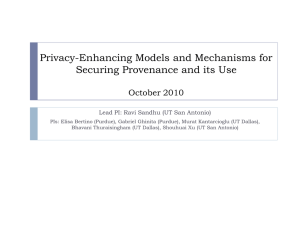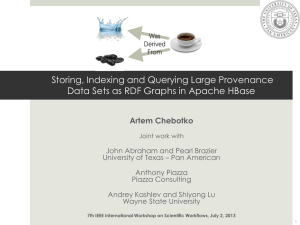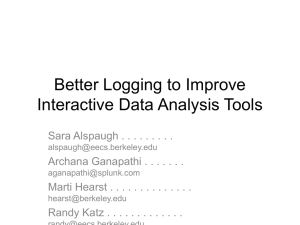CHAPTER 14: PROVENANCE
advertisement
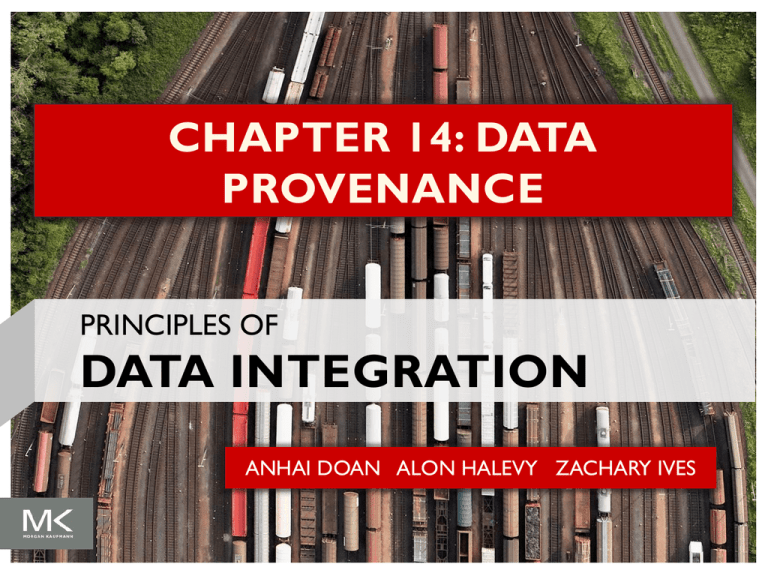
CHAPTER 14: DATA PROVENANCE PRINCIPLES OF DATA INTEGRATION ANHAI DOAN ALON HALEVY ZACHARY IVES “Where Did this Data Come from?” Challenge: integrated data may come from many sources and mappings – of different quality or trustworthiness! How did I get this particular result? What mappings produced it? How much should I trust (believe) it? Data provenance (lineage) captures the relationships between tuples in a set of data instances 2 An Example: View Tuple Derivations Source relations R A B S B C 1 2 2 3 2 4 3 2 4 3 View V1 = R ⋈ S ∪ S ⋈ S A C directly derivable by 1 3 R(1,2) ⋈ S(2,3) ∪ R(1,4) ⋈ S(4,3) 2 2 S(2,3) ⋈ ρB A, C B S(3,2) 3 3 S(3,2) ⋈ ρB A, C B S(2,3) 3 Formulating a Provenance Model Conceptually, provenance captures the operations and operands going into a result There are many options to do this, and many levels of detail! A “good” provenance model should: Have a formal semantics Have equivalence properties such that equivalent query plans produce equivalent provenance Connect to notions of value, quality or score 4 Outline The two views of provenance Applications of data provenance Provenance semirings: one ring to rule them all Storing provenance 5 Provenance as Annotations on Data Annotate each derivation with an “explanation” in terms of relational algebra and the tuple operands Lets us “look up” the derivation of a result R S A B 1 2 1 4 B C 2 3 3 2 4 3 View V1 (in Datalog): V1(x,z) :- R(x,y), S(y,z) V1(x,x) :- S(x,y), S(y,x) A C provenance annotation 1 3 R(1,2) ⋈ S(2,3) ∪ R(1,4) ⋈ S(4,3) 2 2 S(2,3) ⋈ ρB A, C B S(3,2) 6 Provenance as a Graph of Relationships Bipartite graph: tuple nodes connected via “derivation nodes” Encodes a hypergraph (hyperedges = derivations) Makes direct derivation relationships more explicit derives via V1 R(1,4) S(4,3) derives via V1 R(1,2) S(2,3) V1(1,3) derives via V1 S(3,2) V1(2,2) derives via V1 V1(3,3) 7 Making the Two Interchangeable We can make these equivalent by introducing provenance tokens (equiv. node IDs) for each tuple Derived tuples’ annotations = expressions over tokens R V1 A B ann 1 2 r1 1 4 r2 r2 V1 r1 S s3 B C ann 2 3 s1 3 2 4 3 V1 A C ann s1 s2 1 3 s2 v1 = r1 ⋈ s1 ∪ r2 ⋈ s3 2 2 s3 v2 = s1 ⋈ s2 3 3 v3 = s2 ⋈ s1 v1 V1 V1 v2 v3 8 Outline The two views of provenance Applications of data provenance Provenance semirings: one ring to rule them all Storing provenance 9 Where Can We Use Provenance? Explanations Help the user understand why an item exists Scoring Provide a ranked list of “most relevant” results Reasoning about interactions Help the user understand data relationships Examples of Provenance’s Utility Schema mapping debugging: We may have a bad result Determine why that result exists, what is faulty Bioinformatics data integration: Different sources have different levels of reliability or authoritativeness Rank results by score! Probabilistic databases: We may need to know that results are correlated Encode the relationships, use to assign probabilities Outline The two views of provenance Applications of data provenance Provenance semirings: one ring to rule them all Storing provenance 12 The Notion of Provenance as Annotations Many formalisms were defined for using query computations to produce annotations Each captured certain subtleties The key question: Is there one “most powerful” model that captures the properties of the relational algebra*? Equivalent queries should produce equivalent provenance * over multi-sets or bags, as used by “real” systems The Provenance Semiring Model To represent provenance, use: A set of provenance tokens or tuple IDs, K Abstract operators representing combination of tuples Abstract sum operator, ⊕, for union or projection has identity element 0 (a ⊕ 0 ≡ 0 ⊕ a ≡ 0) Abstract product operator, ⊗, for join has identity element 1 (a ⊗ 1 ≡ 1 ⊗ a ≡ 1) also (a ⊗ 0 ≡ 0 ⊗ a ≡ 0) This is formally a commutative semiring 14 The Provenance Semiring Model We can re-express our example as below, using the semiring operators instead of the relational algebra ones R V1 A B ann 1 2 r1 1 4 r2 r2 V1 r1 S s3 B C ann 2 3 s1 3 2 4 3 V1 A C Ann 1 3 s2 v1 = r1 ⊗ s1 ⊕ r2 ⊗ s3 2 2 s3 v2 = s1 ⊗ s2 3 3 v3 = s2 ⊗ s1 s1 s2 v1 V1 V1 v2 v3 15 Tokens for Mappings Sometimes we would like to assign a token to the actual mapping or rule used – so we can assign it a value R S A B ann 1 2 r1 1 4 r2 B C ann 2 3 s1 3 2 s2 4 3 s3 View V1 (in Datalog): V1(x,z) :- R(x,y), S(y,z) V1(x,x) :- S(x,y), S(y,x) Call this m1 Call this m2 V1 A C Ann 1 3 v1 = m1⊗ [r1 ⊗ s1] ⊕ m2⊗ [r2 ⊗ s3] 2 2 v2 = m2⊗ [s1 ⊗ s2] 16 Example Application: Provenance Visualization Base tuple derivation (token not shown) Tuple nodes Derivation by mapping M5 Example Application: Tuple Scoring For ranked query results, we may adopt the following model commonly used in ranking: Assign a score to each base tuple = - log2(probability) Use arithmetic sum as ⊗ Use min as ⊕ Suppose prob(r1) = 0.5, prob(s1) = 0.5, others are 1.0 V1 A C Ann 1 3 v1 = r1 ⊗ s1 ⊕ r2 ⊗ s3 = min((2+1),(1+1)) = 2 2 2 v2 = s1 ⊗ s2 = 2+1 = 3 3 3 v3 = s2 ⊗ s1 = 1+2 = 3 Useful Semirings Use case Base value Product R ⊗ S Sum R ⊕ S Derivability True R∧S R∨S Trust Trust condition result R∧S R∨S Confidentiality level Tuple confidentiality level More_secure(R, S) Less_secure(R,S) Weight / cost Base tuple weight R+S min(R,S) Lineage Tuple ID R∪S R∩S Probabilistic event Tuple probabilistic event R∧S R∨S Number of 1 R⋅S R+S 19 Outline The two views of provenance Applications of data provenance Provenance semirings: one ring to rule them all Storing provenance 20 Storing Provenance Use tuple keys as tokens Encode provenance graph as relations View V1 (in Datalog): V1(x,z) :- R(x,y), S(y,z) V1(x,x) :- S(x,y), S(y,x) R S Relate tuples with table Pv1-1 Relate tuples with table Pv1-2 A B 1 2 1 4 Pv1-1 R.A R.B S. B S.C V1.A V1.C 1 2 2 3 1 3 1 4 4 3 1 3 V1. A V1. C 2 2 B C 2 3 Pv1-2 S.B S. 3 2 C S.B S. ’ C’ 4 3 3 3 2 2 V1 A C 1 3 2 2 3 3 21 Storing Provenance Use tuple keys as tokens Encode provenance graph as relations View V1 (in Datalog): V1(x,z) :- R(x,y), S(y,z) V1(x,x) :- S(x,y), S(y,x) R S These are redundant if we know the Datalog A B 1 2 1 4 Pv1-1 R.A R.B S. B S.C V1.A V1.C 1 2 2 3 1 3 1 4 4 3 1 3 V1. A V1. C 2 2 B C 2 3 Pv1-2 S.B S. 3 2 C S.B S. ’ C’ 4 3 3 3 2 2 V1 A C 1 3 2 2 3 3 22 Storing Provenance Use tuple keys as tokens Encode provenance graph as relations View V1 (in Datalog): V1(x,z) :- R(x,y), S(y,z) V1(x,x) :- S(x,y), S(y,x) R S A B 1 2 1 4 Pv1-1 A B C 1 2 3 1 4 3 B C B C 2 3 3 2 2 4 3 3 Pv1-2 V1 A C 1 3 C’ 2 2 3 2 3 3 2 3 23 Data Provenance Wrap-up Provenance is critical to understanding and assessing the believability of data, and in debugging Two equivalent representations – annotations vs graph Provenance semiring model preserves the “expected” equivalences of the relational algebra We can take semiring provenance and evaluate it with different semirings to get useful scores We can store provenance using relations Recent work beyond the scope of the book: Extending provenance to more complex queries, e.g., with aggregation Languages for querying provenance (primarily as a graph)

